Abstract
Local cerebral and peripheral blood flow in conscious and anaesthetized rabbits were investigated with the microsphere method, before and after the i.v. administration of 25 or 50 micrograms kg-1 thyrotropin-releasing hormone (TRH). Before the experiment, the cervical sympathetic chain was sectioned on one side in order to evaluate the possible effect of the sympathetic nerves on cranial and extracranial blood flows. Blood flow was also determined in anaesthetized rabbits before and after the administration of the TRH metabolites cyclo(His-Pro) and acid-TRH and after subsequent administration of 50 micrograms kg-1 TRH. TRH caused an increase in mean arterial blood pressure (MAP) of about 1 to 2 kPa whereas cyclo(His-Pro) and acid-TRH had no effect on MAP. In the anaesthetized animal an increase in total cerebral blood flow (CBFtot), from 71 +/- 7 to 107 +/- 12 g min-1 100 g-1 (P less than 0.05) was observed on the sympathetic intact side after 25 micrograms kg-1 TRH and a further increase to 130 +/- 9 g min-1 100g-1 (P less than 0.01) after 50 micrograms kg-1 TRH. A similar effect was observed on the sympathotomized side. An effect on CBF in the conscious animal was not detected. The control CBFtot (104 +/- 8 g min-1 100g-1) was higher in these animals than in the anaesthetized animals (P less than 0.02). Neither cyclo(His-Pro) nor acid-TRH mimicked the effect of TRH on CBF. In several peripheral tissues, e.g. skin, pancreas and gastric mucosa, a reduction in blood flow was noted after the administration of TRH in both anaesthetized and conscious rabbits. It was concluded that TRH can induce cerebral vasodilatation in animals with a depressed CBF, whereas the vasoconstrictor effect of TRH in peripheral organs is not markedly affected by the state of consciousness.
Full text
PDF
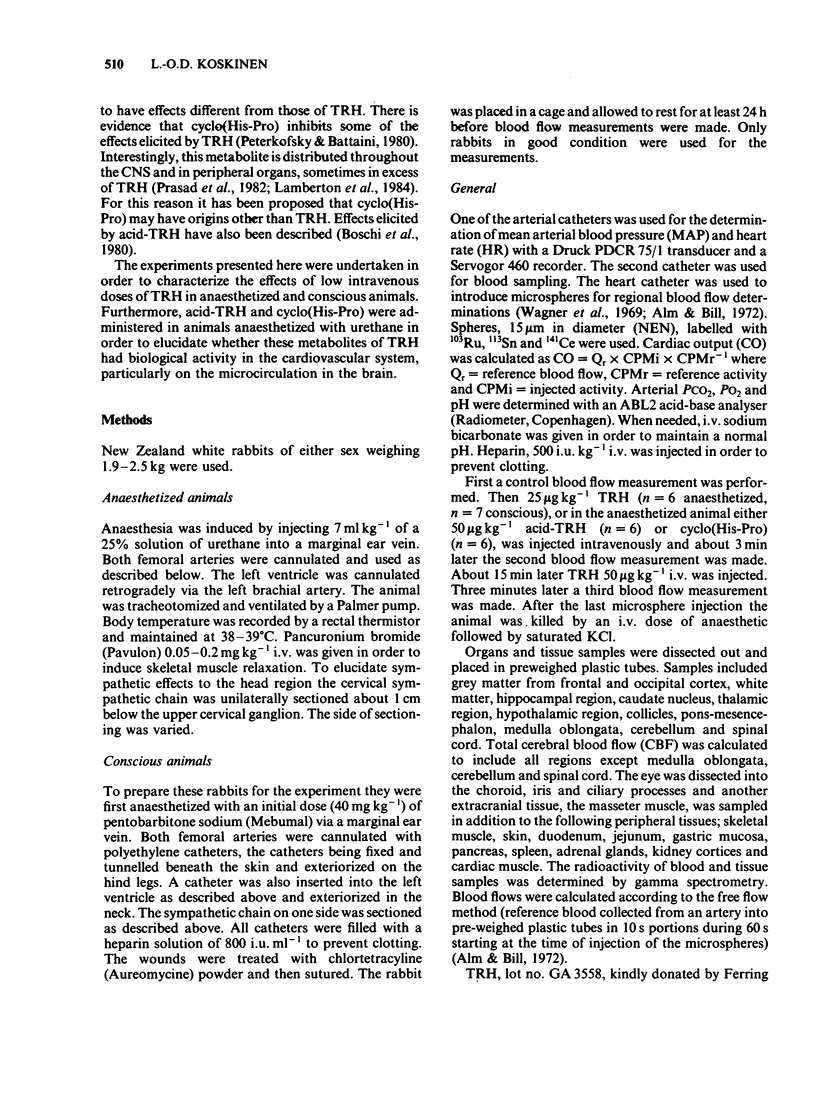
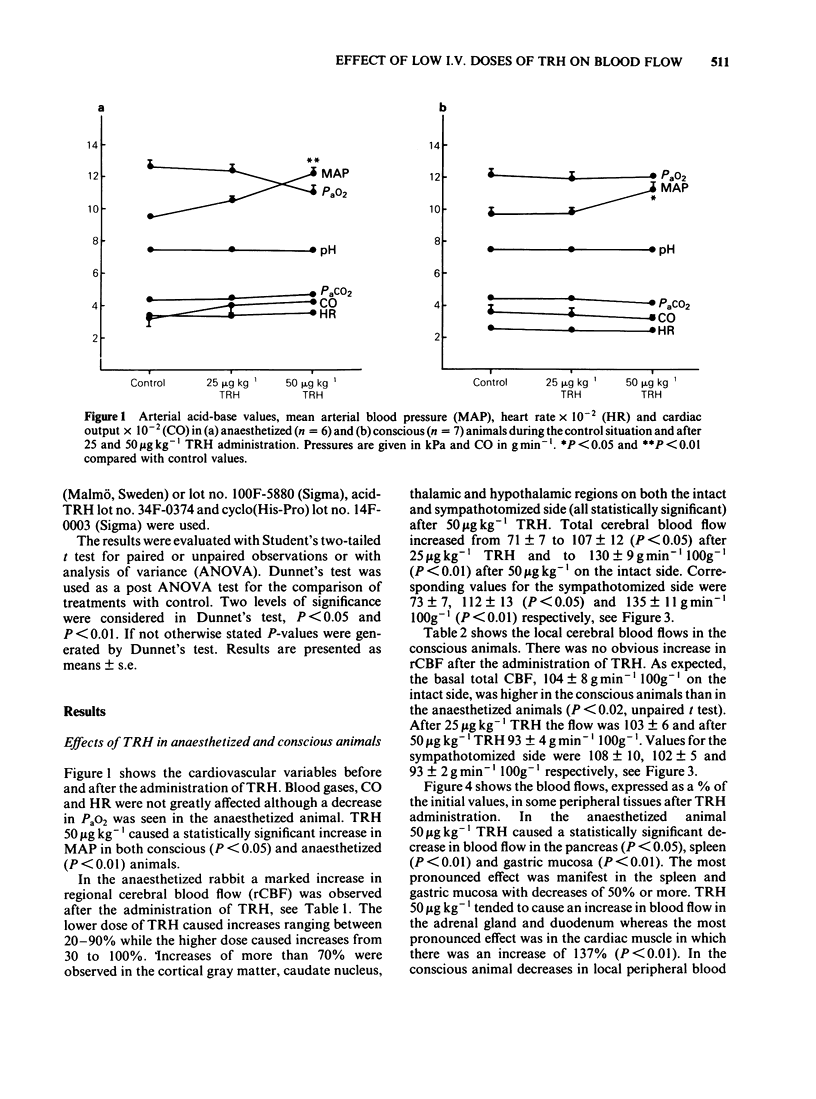
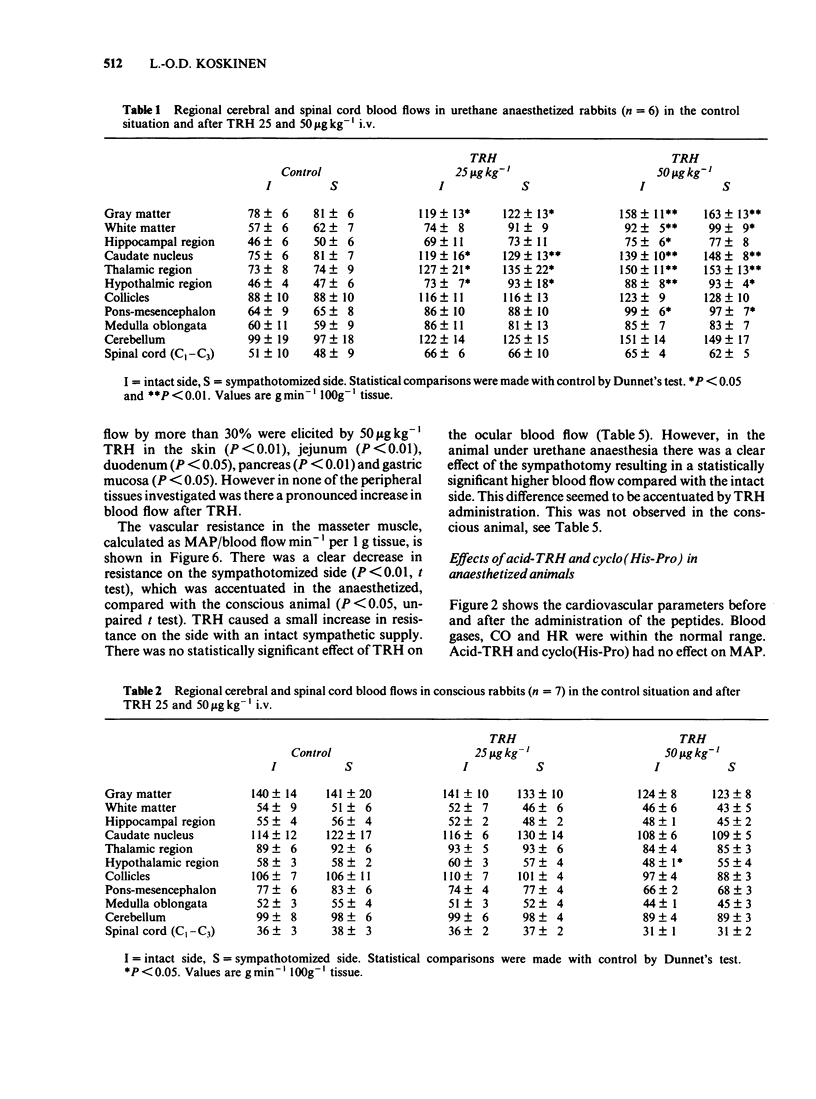
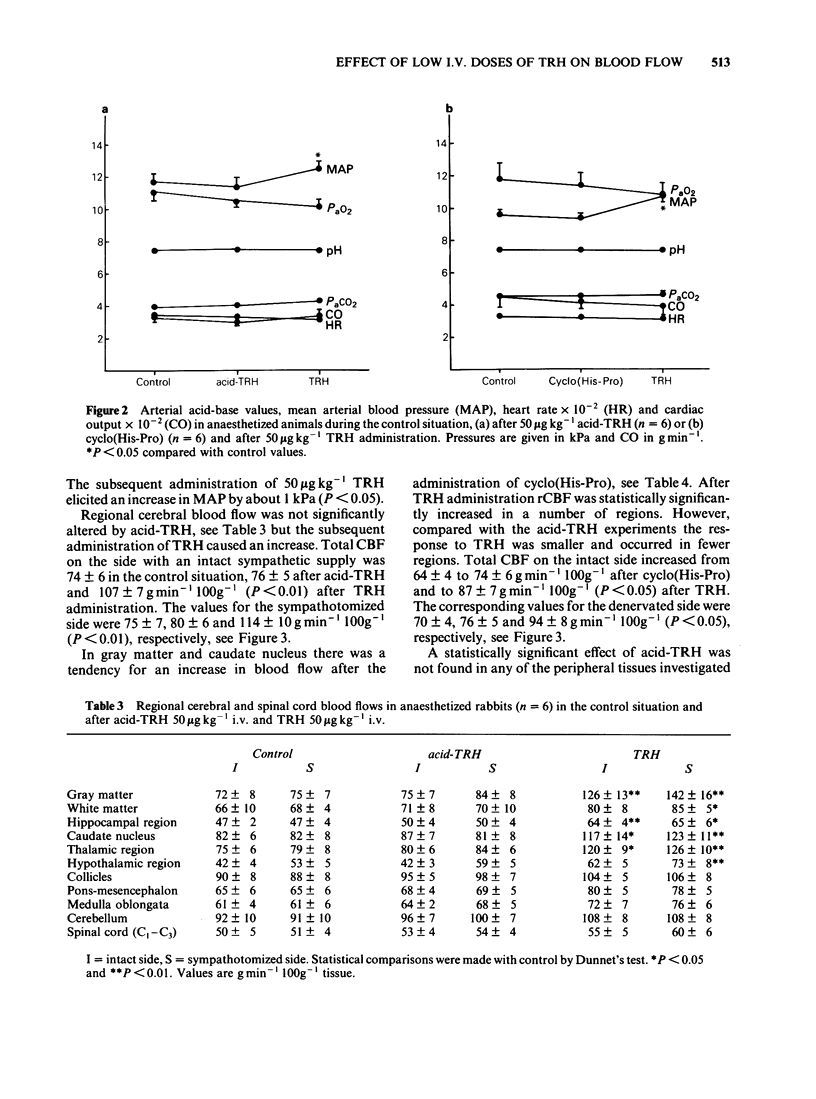
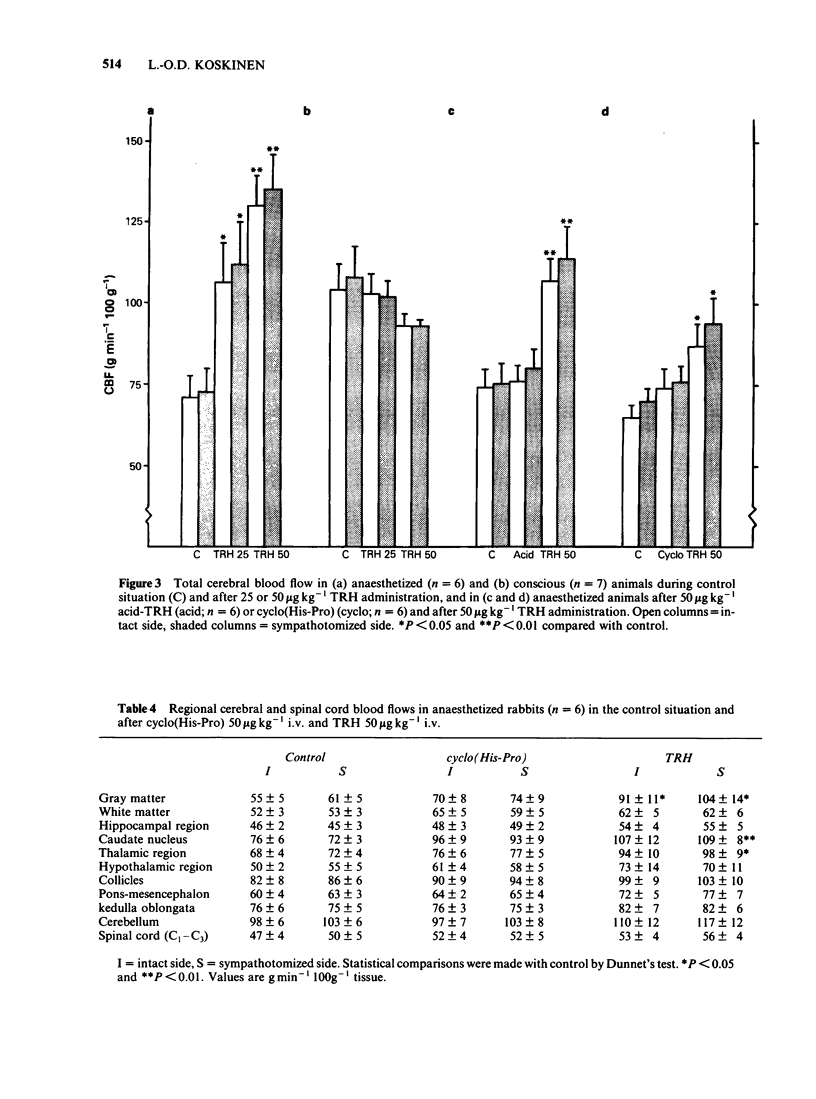
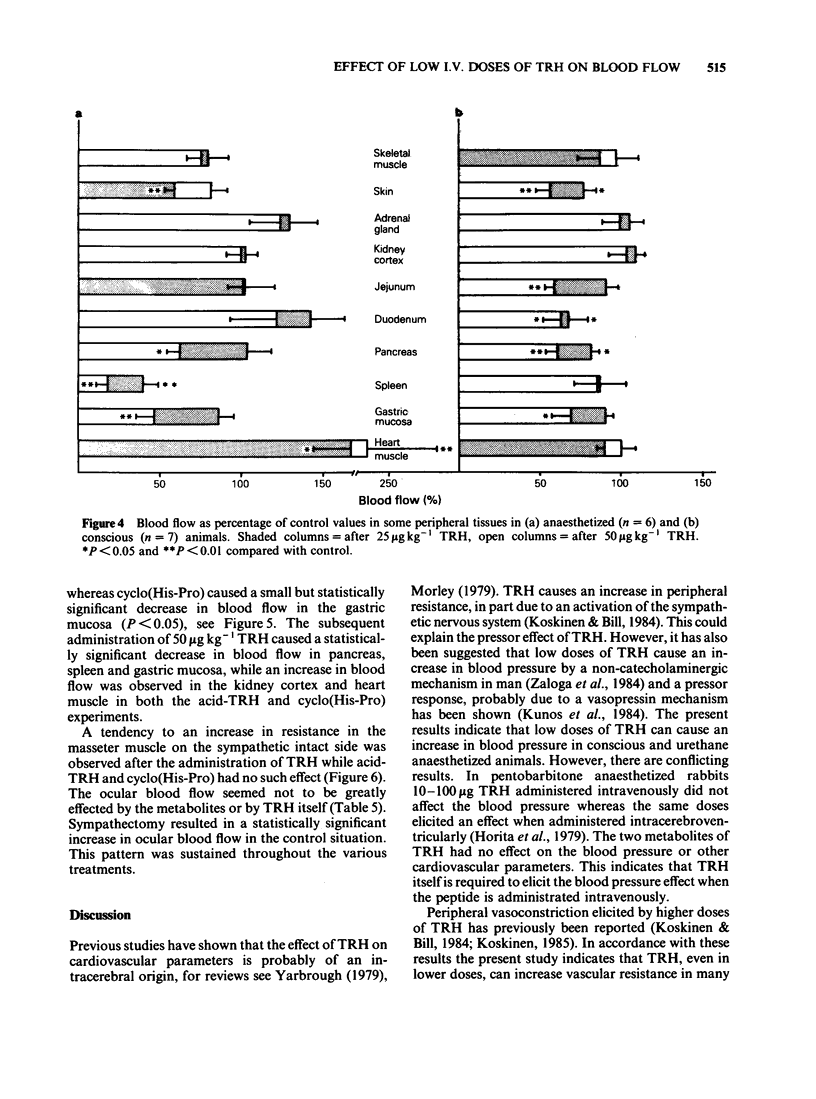


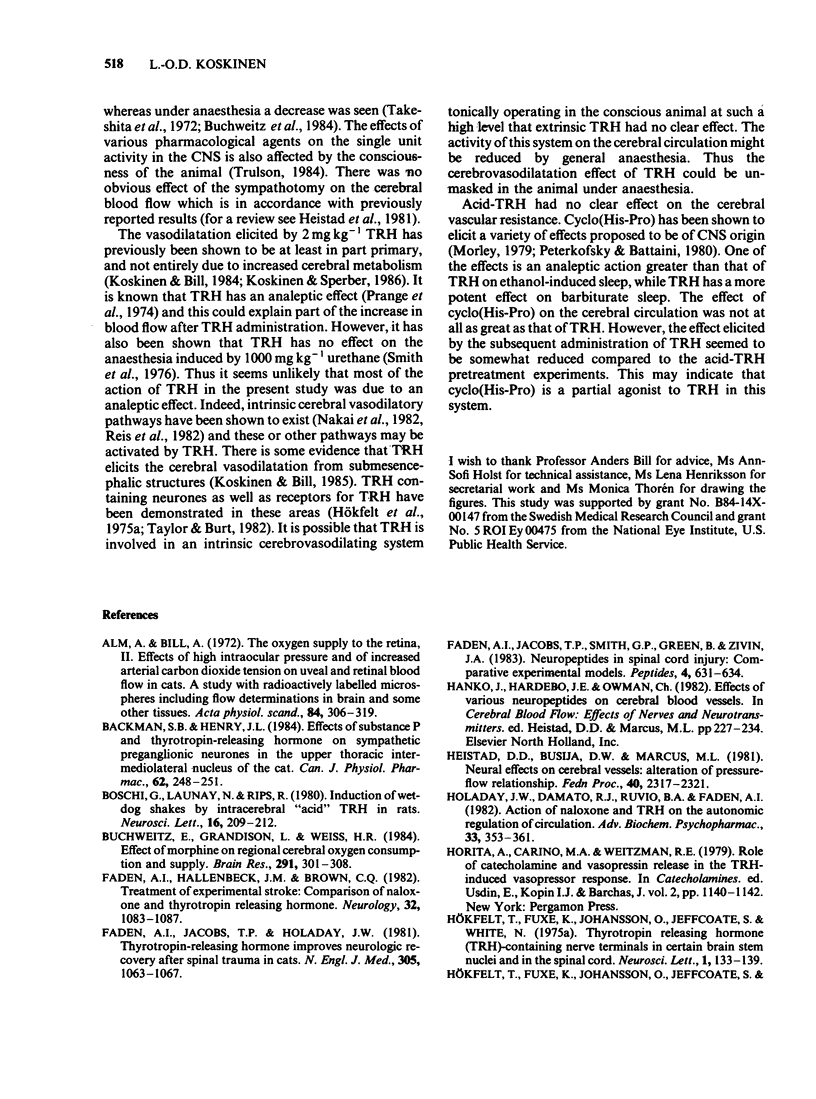

Selected References
These references are in PubMed. This may not be the complete list of references from this article.
- Alm A., Bill A. The oxygen supply to the retina. II. Effects of high intraocular pressure and of increased arterial carbon dioxide tension on uveal and retinal blood flow in cats. A study with radioactively labelled microspheres including flow determinations in brain and some other tissues. Acta Physiol Scand. 1972 Mar;84(3):306–319. doi: 10.1111/j.1748-1716.1972.tb05182.x. [DOI] [PubMed] [Google Scholar]
- Backman S. B., Henry J. L. Effect of substance P and thyrotropin-releasing hormone on sympathetic preganglionic neurones in the upper thoracic intermediolateral nucleus of the cat. Can J Physiol Pharmacol. 1984 Feb;62(2):248–251. doi: 10.1139/y84-038. [DOI] [PubMed] [Google Scholar]
- Boschi G., Launay N., Rips R. Induction of wet-dog shakes by intracerebral 'acid' TRH in rats. Neurosci Lett. 1980 Feb;16(2):209–212. doi: 10.1016/0304-3940(80)90346-8. [DOI] [PubMed] [Google Scholar]
- Buchweitz E., Grandison L., Weiss H. R. Effect of morphine on regional cerebral oxygen consumption and supply. Brain Res. 1984 Jan 23;291(2):301–308. doi: 10.1016/0006-8993(84)91262-9. [DOI] [PubMed] [Google Scholar]
- Faden A. I., Hallenbeck J. M., Brown C. Q. Treatment of experimental stroke: comparison of naloxone and thyrotropin releasing hormone. Neurology. 1982 Oct;32(10):1083–1087. doi: 10.1212/wnl.32.10.1083. [DOI] [PubMed] [Google Scholar]
- Faden A. I., Jacobs T. P., Holaday J. W. Thyrotropin-releasing hormone improves neurologic recovery after spinal trauma in cats. N Engl J Med. 1981 Oct 29;305(18):1063–1067. doi: 10.1056/NEJM198110293051806. [DOI] [PubMed] [Google Scholar]
- Faden A. I., Jacobs T. P., Smith G. P., Green B., Zivin J. A. Neuropeptides in spinal cord injury: comparative experimental models. Peptides. 1983 Sep-Oct;4(5):631–634. doi: 10.1016/0196-9781(83)90009-8. [DOI] [PubMed] [Google Scholar]
- Heistad D. D., Busija D. W., Marcus M. L. Neural effects on cerebral vessels: alteration of pressure-flow relationship. Fed Proc. 1981 Jun;40(8):2317–2321. [PubMed] [Google Scholar]
- Holaday J. W., D'Amato R. J., Ruvio B. A., Faden A. I. Action of naloxone and TRH on the autonomic regulation of circulation. Adv Biochem Psychopharmacol. 1982;33:353–361. [PubMed] [Google Scholar]
- Hökfelt T., Fuxe K., Johansson O., Jeffcoate S., White N. Distribution of thyrotropin-releasing hormone (TRH) in the central nervous system as revealed with immunohistochemistry. Eur J Pharmacol. 1975 Dec;34(2):389–392. doi: 10.1016/0014-2999(75)90269-1. [DOI] [PubMed] [Google Scholar]
- Koskinen L. O., Bill A. Regional cerebral, ocular and peripheral vascular effects of naloxone and morphine in unanesthetized rabbits. Acta Physiol Scand. 1983 Nov;119(3):235–241. doi: 10.1111/j.1748-1716.1983.tb07333.x. [DOI] [PubMed] [Google Scholar]
- Koskinen L. O., Bill A. Thyrotropin-releasing hormone (TRH) causes sympathetic activation and cerebral vasodilation in the rabbit. Acta Physiol Scand. 1984 Oct;122(2):127–136. doi: 10.1111/j.1748-1716.1984.tb07490.x. [DOI] [PubMed] [Google Scholar]
- Koskinen L. O. Effects of raised intracranial pressure on regional cerebral blood flow: a comparison of effects of naloxone and TRH on the microcirculation in partial cerebral ischaemia. Br J Pharmacol. 1985 Jun;85(2):489–497. doi: 10.1111/j.1476-5381.1985.tb08886.x. [DOI] [PMC free article] [PubMed] [Google Scholar]
- Kunos G., Newman F., Farsang C., Ungar W. Thyrotropin releasing hormone and naloxone attenuate the antihypertensive action of central alpha 2-adrenoceptor stimulation through different mechanisms. Endocrinology. 1984 Dec;115(6):2481–2483. doi: 10.1210/endo-115-6-2481. [DOI] [PubMed] [Google Scholar]
- Lamberton R. P., Lechan R. M., Jackson I. M. Ontogeny of thyrotropin-releasing hormone and histidyl proline diketopiperazine in the rat central nervous system and pancreas. Endocrinology. 1984 Dec;115(6):2400–2405. doi: 10.1210/endo-115-6-2400. [DOI] [PubMed] [Google Scholar]
- Lang R. E., Brückner U. B., Kempf B., Rascher W., Sturm V., Unger T., Speck G., Ganten D. Opioid peptides and blood pressure regulation. Clin Exp Hypertens A. 1982;4(1-2):249–269. doi: 10.3109/10641968209061589. [DOI] [PubMed] [Google Scholar]
- Leppäluoto J., Koivusalo F., Kraama R. Thyrotropin-releasing factor: distribution in neural and gastrointestinal tissues. Acta Physiol Scand. 1978 Oct;104(2):175–179. doi: 10.1111/j.1748-1716.1978.tb06264.x. [DOI] [PubMed] [Google Scholar]
- Miller R. L., Forsyth R. P., Melmon K. L. Morphine-induced redistribution of cardiac output in the unanesthetized monkey. Pharmacology. 1972;7(3):138–148. doi: 10.1159/000136283. [DOI] [PubMed] [Google Scholar]
- Morley J. E. Extrahypothalamic thyrotropin releasing hormone (TRH) -- its distribution and its functions. Life Sci. 1979 Oct 29;25(18):1539–1550. doi: 10.1016/0024-3205(79)90435-1. [DOI] [PubMed] [Google Scholar]
- Morley J. E., Garvin T. J., Pekary A. E., Hershman J. M. Thyrotropin-releasing hormone in the gastrointestinal tract. Biochem Biophys Res Commun. 1977 Nov 7;79(1):314–318. doi: 10.1016/0006-291x(77)90097-3. [DOI] [PubMed] [Google Scholar]
- Naftchi N. E. Prevention of damage in acute spinal cord injury by peptides and pharmacologic agents. Peptides. 1982 May-Jun;3(3):235–247. doi: 10.1016/0196-9781(82)90084-5. [DOI] [PubMed] [Google Scholar]
- Nakai M., Iadecola C., Reis D. J. Global cerebral vasodilation by stimulation of rat fastigial cerebellar nucleus. Am J Physiol. 1982 Aug;243(2):H226–H235. doi: 10.1152/ajpheart.1982.243.2.H226. [DOI] [PubMed] [Google Scholar]
- Ogawa N., Mizuno S., Mori A., Nukina I., Ota Z., Yamamoto M. Potential anti-depressive effects of thyrotropin releasing hormone (TRH) and its analogues. Peptides. 1984 Jul-Aug;5(4):743–746. doi: 10.1016/0196-9781(84)90016-0. [DOI] [PubMed] [Google Scholar]
- Prange A. J., Jr, Breese G. R., Cott J. M., Martin B. R., Cooper B. R., Wilson I. C., Plotnikoff N. P. Thydrotropin releasing hormone: antagonism of pentobarbital in rodents. Life Sci. 1974 Feb 1;14(3):447–455. doi: 10.1016/0024-3205(74)90359-2. [DOI] [PubMed] [Google Scholar]
- Prange A. J., Jr, Lara P. P., Wilson I. C., Alltop L. B., Breese G. R. Effects of thyrotropin-releasing hormone in depression. Lancet. 1972 Nov 11;2(7785):999–1002. doi: 10.1016/s0140-6736(72)92407-5. [DOI] [PubMed] [Google Scholar]
- Prasad C., Mori M., Wilber J. F., Pierson W., Pegues J., Jayaraman A. Distribution and metabolism of cyclo (His-Pro): a new member of the neuropeptide family. Peptides. 1982 May-Jun;3(3):591–598. doi: 10.1016/0196-9781(82)90129-2. [DOI] [PubMed] [Google Scholar]
- Smith J. R., Carino M. A., Horita A. Interaction of various anesthetic agents with TRH: effects on temperature and arousal in rabbits. Proc West Pharmacol Soc. 1976;19:214–215. [PubMed] [Google Scholar]
- Sobue I., Takayanagi T., Nakanishi T., Tsubaki T., Uono M., Kinoshita M., Igata A., Miyazaki M., Yoshida M., Ando K. Controlled trial of thyrotropin releasing hormone tartrate in ataxia of spinocerebellar degenerations. J Neurol Sci. 1983 Oct;61(2):235–248. doi: 10.1016/0022-510x(83)90008-4. [DOI] [PubMed] [Google Scholar]
- Takeshita H., Michenfelder J. D., Theye R. A. The effects of morphine and N-allylnormorphine on canine cerebral metabolism and circulation. Anesthesiology. 1972 Dec;37(6):605–612. doi: 10.1097/00000542-197212000-00007. [DOI] [PubMed] [Google Scholar]
- Taylor R. L., Burt D. R. Species differences in the brain regional distribution of receptor binding for thyrotropin-releasing hormone. J Neurochem. 1982 Jun;38(6):1649–1656. doi: 10.1111/j.1471-4159.1982.tb06646.x. [DOI] [PubMed] [Google Scholar]
- Wagner H. N., Jr, Rhodes B. A., Sasaki Y., Ryan J. P. Studies of the circulation with radioactive microspheres. Invest Radiol. 1969 Nov-Dec;4(6):374–386. doi: 10.1097/00004424-196911000-00004. [DOI] [PubMed] [Google Scholar]
- Yarbrough G. G. On the neuropharmacology of thyrotropin releasing hormone (TRH). Prog Neurobiol. 1979;12(3-4):291–312. doi: 10.1016/0301-0082(79)90012-1. [DOI] [PubMed] [Google Scholar]
- Zaloga G. P., Chernow B., Zajtchuk R., Chin R., Rainey T. G., Lake C. R. Diagnostic dosages of protirelin (TRH) elevate BP by noncatecholamine mechanisms. Arch Intern Med. 1984 Jun;144(6):1149–1152. [PubMed] [Google Scholar]


